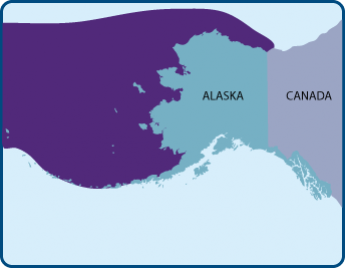Alaska Species Explorer
All
x
- – No known individuals remaining.
- – Known only to survive in captivity, or as a naturalized population outside its historic range.
- – Extremely high risk of extinction in the wild.
- – High risk of extinction in the wild.
- – High risk of endangerment in the wild.
- – Likely to become endangered in the near future.
- – Lowest risk. Does not qualify for a higher risk category. Widespread and abundant taxa are included in this category.
- – Not enough data to make an assessment of its risk of extinction.
- – Has not yet been evaluated against the criteria.
Pacific Walrus
- – No known individuals remaining.
- – Known only to survive in captivity, or as a naturalized population outside its historic range.
- – Extremely high risk of extinction in the wild.
- – High risk of extinction in the wild.
- – High risk of endangerment in the wild.
- – Likely to become endangered in the near future.
- – Lowest risk. Does not qualify for a higher risk category. Widespread and abundant taxa are included in this category.
- – Not enough data to make an assessment of its risk of extinction.
- – Has not yet been evaluated against the criteria.
Mainly inhabits the shallow continental shelf waters of the Bering and Chukchi seas. Virtually the entire population occupies the pack ice in the Bering Sea in the winter months. Through the winter they generally congregate in two areas, one immediately southwest of St. Lawrence Island and the other in outer Bristol Bay. As the Bering Sea pack ice begins to loosen in April, walruses begin to move northward and their distribution becomes less clumped. By late April the distribution extends from Bristol Bay northward to the Bering Strait. In Alaska, major terrestrial haulouts are found in Bristol Bay at Cape Seniavin, Round Island, Cape Pierce, and Cape Newenham.
Difficulties in population surveys lead to an estimate of 50,000-500,000 in the current population. U.S Fish and Wildlife Service (USFWS) recommends a listing of threatened on the Endangered Species List, however other high priority species have precluded the listing. They are currently working on a proposal for the listing and establishing critical habitat recommendations.
The walrus has the lowest reproductive rate of any pinniped species. The 3-4 month delay before implantation of the embryo, followed by approximately 11 months of active gestation results in a reproductive cycle of more than one year. A pregnancy which lasts through the next breeding season lowers the minimum interval between successful births to 2 years.
Although capable of diving to deeper depths, Pacific walruses for the most part are found in waters of 100 m or less, possibly because of higher productivity of their benthic foods in the shallower water. Feeding areas typically are composed of sediments of soft, fine sands. Pack ice serves as a substrate for resting and giving birth, and walruses require pack ice that will support their weight and allow ready access to the water in which they forage.
Reduction in sea ice, killer whales, polar bears, subsistence hunting, and haulout disturbance
- Both males and females have ivory tusks
- As sea ice continues to recede walrus congregate more on land.
For more information about how the ASLC is studying walruses follow this link:
www.alaskasealife.org/New/education/VFT/WATCHING%20WALRUS/WalrusVFT_Introduction.php










